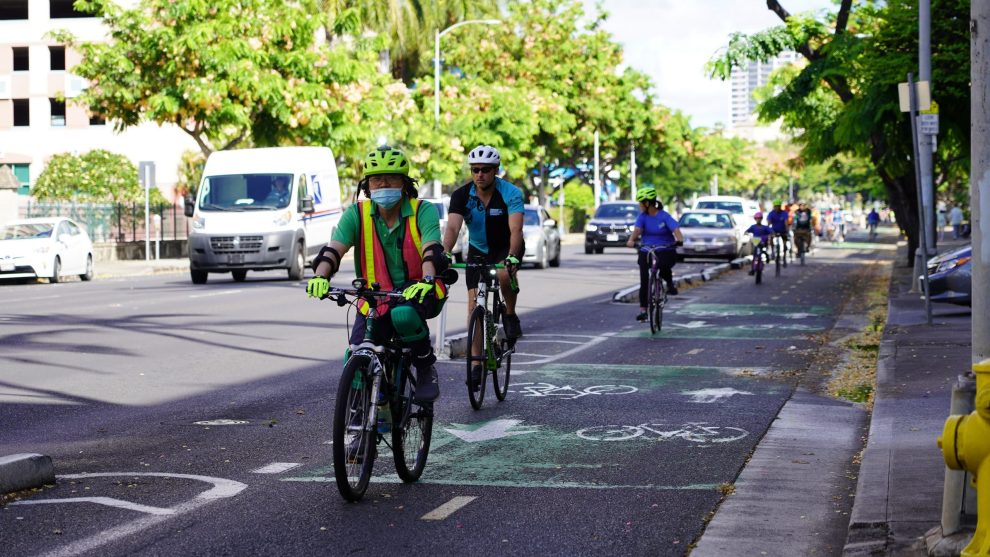Financial incentives will offset the cost of e-bikes, but is that enough to offset the danger of riding them in Honolulu traffic?
A new state-funded rebate program is aimed at encouraging more people to commute on e-bikes and electric mopeds instead of cars, while helping to reduce the rising costs of both living and transportation for residents.
The program, created through Act 306, allows anyone who has purchased an e-bike or electric moped at a retail store after July 1 and meets certain other criteria to get back either 20% of the retail cost or $500, whichever amount is lower.
To qualify you must be over 18, fill out this application and meet at least one of the eligibility criteria: participate in a low-income assistance program (such as Section 8), not own a motor vehicle with four or more wheels and currently be enrolled at a school or college.
The cost of new e-bikes ranges from $1,000 to $3,000, so this rebate would be helpful in offsetting that expense. And the popularity for this way of getting around is way up in the U.S.
The pandemic fueled a boom in bikes, period, and e-bike sales in particular grew by an astounding 240% in the year ending in 2021, according to the market research firm NPD Group. That means e-bikes are outpacing the sale of electric cars, owners of which already get government subsidies. Why shouldn’t e-bike riders get a break, too?
This comes at a time, too, when traffic fatalities are rising. In 2022, Hawaii had 103 traffic-related deaths, the highest number since 108 in 2019, according to the state Department of Transportation.
Already, in 2023, 16 people have been killed on state roads — 11 on Oahu alone — including three on scooters and one bicyclist.
I’m all for more people ditching their cars — lessening roadway traffic and carbon emissions — and finding alternative ways to get around. When I was working in Downtown Honolulu, I walked three miles to the office and caught the bus back home.
But would I brave Pali Highway and the narrow streets of nearby neighborhoods on a bike, even an e-bike? And in this rain? No way.

There was a time when I rode a bike to work. I lived in Aina Haina and worked near Diamond Head. It took me about half an hour to bike to work — and I gripped those handlebars for dear life. One section, just as Kalanianaole Highway turns into H1, is especially harrowing; the bike lane just ends as cars whip by on the Waialae off-ramp by Kahala Mall.
I ended my regular bike commutes after a near-accident on Kalakaua Avenue by the Waikiki Aquarium. The bike lanes there are on the streetside of the parking stalls on the makai end of the road. As I rode along, a driver who didn’t see me suddenly swung his car door open. I swerved into the street and fell off my bike. Luckily, there were no oncoming cars; otherwise, I don’t think I would have survived with just a few scratches and bruises.
What will get more people on bikes, e-bikes and scooters isn’t just financial help. It’s safer roadways.
“That’s the other half of the equation,” agrees Sen. Chris Lee, chair of the Transportation and Culture and the Arts committee. “How do we go about creating a safe and protected infrastructure that enables people to walk, bike, scoot without having to worry about being killed? It’s problematic.”
He points to Vision Zero, a multinational road traffic safety project that started in Sweden and aims to achieve zero traffic deaths and injuries by prioritizing safety over speed and convenience when it comes to roadways. It can be done, he says, but it will take time. Like, decades. But it can happen.
“There’s an assumption in the U.S., and Hawaii, too, that these kinds of fatalities and dangers on the road is an accepted way of life, and we just have to deal with it” Lee says. “That has to change.”
There has been progress in making Hawaii a more pedestrian- and bike-friendly state. In 2014 Honolulu’s first protected bike lane was installed on King Street, resulting in a 50% reduction in pedestrian-vehicle collisions, according to the state.
Six years later another protected, two-way bike lane opened on Pensacola Street, connecting Makiki to the King Street bike path.
The state’s first bike-sharing program, Biki, launched in urban Honolulu in 2017. It reported more than 1 million total rides in 2021, the latest data available, up 31% from 2020.
Of those surveyed, 59% said they use Biki to commute and 49% said they signed up to drive less.
In a mark of success, the League of American Bicyclists ranked Hawaii 27th nationally as a bicycle-friendly state — an improvement from years past.
Lee also mentioned a future project to build a bike path that runs from Nanakuli all the way to Manoa.
“There’s an urgency for all of this,” he says. “Our safety stats have been getting worse … That’s why this stuff is being rolled out as fast as we can.”
I think I’ll wait on getting that e-bike for now.
Source: Civilbeat



























